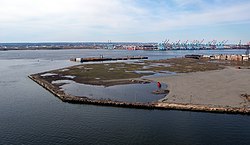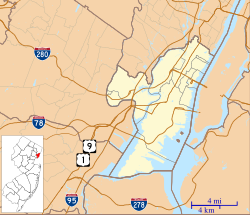Bergen Point | |
|---|---|
 Southwestern tip of Bergen Point | |
| Coordinates: 40°38′51″N74°08′29″W / 40.64750°N 74.14139°W | |
| Country | United States |
| State | |
| County | Hudson |
| City | Bayonne |
| Elevation | 7 ft (2.1 m) |
| Area code | 201 |
| GNIS feature ID | 874681 [1] |
Bergen Point is a point of land that lends its name to the adjacent neighborhood in Bayonne in Hudson County, in the U.S. state of New Jersey. [2] The point is located on the north side of Kill van Kull at Newark Bay. It is the section of the city closest to the Bayonne Bridge. [3] Historically the term has been used more broadly as synonymous with Constable Hook, from which it is geographically separated at Port Johnson.




